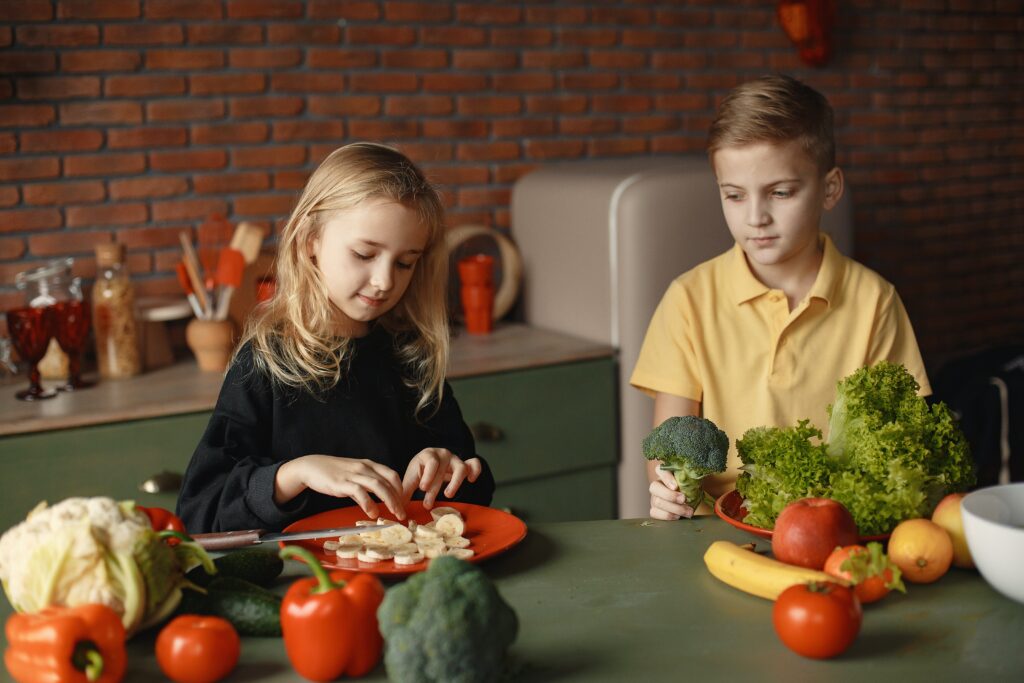Getting kids to eat vegetables can be challenging, but with the right strategies, you can make it easier and even more enjoyable. Here are some effective ways to encourage your children to eat more vegetables:
- Start Early
- Be a Role Model
- Make Vegetables Fun
- Involve Them in Cooking
- Sneak Vegetables into Favorite Foods
- Offer a Variety
- Be Patient and Persistent
- Create Positive Associations
- Use Dips and Dressings
- Educate and Explain
Encouraging children to eat vegetables can often seem like an uphill battle, but it’s crucial to fostering healthy eating habits. Parents and caregivers can find success by incorporating creativity into the presentation of veggies, turning mealtime into a fun, interactive experience.
Understanding The Importance Of Vegetables In A Child’s Diet

Vegetables are powerhouses of nutrients, vitamins, and fiber essential for a growing child’s health. They help in building a strong foundation for a healthy lifestyle. Daily veggies can lead to lasting habits that fight diseases and obesity.
| Vegetable | Key Nutrients | Benefits |
|---|---|---|
| Spinach | Iron, Calcium | Builds strong bones |
| Carrots | Vitamin A | Improves vision |
| Broccoli | Vitamins C, K | Strengthens immunity |
Common Challenges Parents Face
- Picky eaters reject veggie textures or flavors.
- Food ruts make meal plans repetitive and boring.
- Kids favor sugary snacks over healthy options.
- Time constraints limit meal preparation.
Despite these hurdles, with patience and creativity, parents can turn the tide in the battle of the greens.
Best Tips On How To Get Kids to Eat Vegetables
Parents know the struggle of getting kids to eat their greens. But with a few clever strategies, you can help turn veggie time into a fun, enjoyable experience. Let’s explore how to encourage your little ones to make friends with veggies!
Incorporating Vegetables Into Favorite Dishes
Mixing veggies with well-loved recipes can be a game-changer. Here are some ideas:
- Blend spinach into smoothies or sauces.
- Add grated carrots or zucchini to pasta dishes.
- Top pizzas with colorful peppers and tomatoes.
These simple additions boost nutritional value and flavor. Kids often won’t even notice!
Making Vegetables Fun And Appealing
Present veggies in an exciting way to spark interest.
| Vegetable | Idea |
|---|---|
| Celery | Create ‘ants on a log’ with peanut butter and raisins. |
| Broccoli | Turn it into ‘trees’ that giants (kids!) can munch on. |
| Carrots | Cut them into fun shapes with cookie cutters. |
The Power Of Choice And Involvement In Meal Preparation
Giving kids a say and a role in meal prep makes a difference.
- Let them pick veggies at the store.
- Have them wash or mix veggies in the kitchen.
- Encourage them to help arrange veggie plates.
This approach builds excitement and ownership. They’re likely to eat what they’ve helped create!

Nutritional Education And Habit Formation
Getting kids to love veggies is a tricky game. Nutritional Education and Habit Formation are key players. Why? They transform “yuck” into “yum” for little taste buds. Let’s dig into some strategies that make greens their new best friends.
Teaching Kids About The Benefits Of Vegetables
Children are curious. Use their curiosity to teach them why vegetables are superhero foods. Start with simple facts:
- Carrots help you see in the dark.
- Spinach makes your muscles strong.
- Peas are brainpower boosters.
Interactive games and colorful charts can make learning even more fun. Show them how veggies help them run faster, jump higher, and think quicker!
Creating A Routine And Helpful Habits
Routines make healthy choices second nature. Set specific times for veggie snacks. Try these tips:
- Chop veggies for easy access.
- Pair them with your favorite dips.
- Involve kids in picking and preparing their snacks.
Consistency is crucial. A daily veggies habit will stick with repetition and positive reinforcement.
Cultivating A Long-term Palate For Vegetables
Kids’ taste preferences develop early. A varied veggie menu can shape their palate for life. Here’s how:
- Introduce new vegetables often.
- Mix veggies into beloved dishes.
- Encourage tasting, even if they don’t finish it.
Celebrate their bravery when trying new veggies. Appreciate their efforts. Over time, they’ll not only accept but crave their greens.
Addressing Picky Eating
Getting kids to eat vegetables can test a parent’s patience. Picky eating is a common hurdle. But there are ways to make greens fun for your little ones. Let’s dive into strategies to help your children enjoy their veggies.
Identifying And Overcoming Picky Eating Behaviors
Understanding why kids say ‘no’ to vegetables is the first step. Some kids dislike certain textures or colors. Others might be influenced by peers or simply seek control over their choices.
- Introduce new vegetables slowly.
- Include your kids in meal planning and preparation.
- Create fun shapes or characters with veggies.
- Reward trying new foods, not just finishing them.
Small wins lead to big changes. Consistency turns ‘yuck’ into ‘yum.’
When To Seek Professional Help
If picky eating persists or worsens, it may be time to seek help. A few signs include:
| Sign | When to Worry |
|---|---|
| Limited Diet | Less than 20 foods |
| Weight Loss | Sudden or severe |
| Mealtime Distress | Regular tantrums or anxiety |
Healthcare providers can offer tailored advice and support.
Patience And Consistency: Key Factors In Dietary Changes
Small steps and steady support matter when introducing new foods. Trying the same vegetable in different recipes or forms can make a difference. Celebrate your child’s progress and be patient. Dietary changes take time.
- Stick with a routine.
- Gentle encouragement goes a long way.
- Repeat exposure to new foods helps acceptance.
Consistency builds healthy habits that last a lifetime.
Interactive And Supportive Approaches
Getting kids to eat their greens can be fun and educational. Interactive and supportive methods are key to encouraging healthy eating habits. Let’s dive into activities that make vegetables exciting for children.
Gardening: Growing Vegetables With Your Kids
Dirt, seeds, water, and a little bit of patience lead to a magical experience for kids. Gardening is a hands-on activity that teaches kids where food comes from.
- Pick out easy-to-grow veggies like carrots and tomatoes.
- Give your child their own little plot or pot to care for.
- Celebrate success when veggies grow and can be eaten.
Educational Tools And Games About Healthy Eating
Games and apps can make learning about veggies fun. Children can play and learn about healthy eating at the same time.
- Try apps that turn veggies into characters.
- Look for board games focused on food and nutrition.
- Use coloring books that feature different vegetables.
The Role Of Positive Reinforcement And Rewards
Rewards and positive reinforcement help make eating vegetables a positive experience for kids.
| Activity | Reward |
|---|---|
| Eat a new veggie | Sticker or extra playtime |
| Help make dinner | Choose a movie to watch |
| Finish their salad | Small toy or book |
Create a chart to track their veggie eating habits. Praise them when they try something new or eat their veggies without fuss.
Fostering A Healthy Relationship With Food

Helping kids enjoy vegetables is a major step toward a lifelong healthy diet. By using strategies that work and listening to advice from other parents, you’re not just adding greens to their plates; you’re instilling food wisdom. Let’s celebrate progress and continue exploring the diverse world of veggies together!
Success Stories: Transformations And Tips From Other Parents
- Kale chips overcame pickiness: One mom turned kale into a fun snack, and her kids loved it!
- Grow a garden for engagement: A family found that growing veggies increased their kids’ willingness to try them.
- Hidden veggies in sauces: Pureeing vegetables into sauces worked wonders for a skeptical eater.
Summary Of Key Takeaways
Introduce veggies with fun: Make meals colorful and exciting. Get kids involved. Be patient and positive: Keep offering new options without pressure. Lead by example: Eat vegetables yourself and share the experience.
Encouraging Continued Exploration And Openness To New Foods
Nurture an adventurous palate in young eaters. Rotate different vegetables. Praise their bravery when they try something new. Keep the journey enjoyable and stress-free. Your dedication makes a world of difference!

The Bottom Line
Encouraging kids to love veggies can spark a lifelong journey of healthy eating. Start small, stay creative, and be patient. Celebrate their victories with greens and remember, your habits set the stage. With these tips, your home can become a haven for vegetable enthusiasts, one crunchy carrot at a time.
Frequently Asked Questions Of Get Kids To Eat Vegetables
What Do You Do If Your Child Won’t Eat Vegetables?
Encourage trying new vegetables in fun, creative ways. Pair them with favorite foods, involve your child in meal prep, and don’t force consumption. Offer rewards for tasting, but remain patient and avoid making mealtime stressful.
How Can I Get My Kids To Eat More Vegetables?
Encourage kids to eat more vegetables by making dishes colorful and fun. Offer a variety, involve them in shopping and prep, and consistently introduce new options alongside favorites. Model healthy eating habits and praise their efforts when they try something new.
How Do You Get Picky Eaters To Eat Vegetables?
To encourage picky eaters to try vegetables, offer them in fun shapes, pair them with favorite dips, and include them in favorite dishes. Lead by example by eating vegetables yourself, and give praise when they try new ones. Consistency is key; keep offering a variety without pressure.
Should I Punish My Child For Not Eating Vegetables?
Punishing children for not eating vegetables isn’t recommended. Offer veggies in a variety of forms and pair them with foods they enjoy. Make mealtime positive to encourage healthy eating habits.
How to Get an 8-Year-Old to Eat Vegetables?
- Make Vegetables Fun and Appealing: Use creative presentations like vegetable shapes or arrange them in fun patterns on the plate.
- Involve Them in Meal Prep: Let your 8-year-old help with cooking. They can wash, peel, or chop vegetables, which increases their interest in eating them.
- Offer Choices: Provide a variety of vegetables and let them choose which ones they want to try. This gives them a sense of control.
- Mix Vegetables into Favorite Foods: Add vegetables to dishes they already like, such as pasta, soups, or smoothies.
- Be a Role Model: Show your enjoyment of vegetables by eating them regularly and enthusiastically.
How to Get Your Toddler to Eat Vegetables: Recipes?
Veggie Muffins:
- Ingredients: grated carrots, zucchini, whole wheat flour, eggs, and a touch of honey.
- Instructions: Mix all ingredients, pour into muffin tins, and bake until golden.
Smoothie Popsicles:
- Ingredients: spinach, bananas, yogurt, and berries.
- Instructions: Blend ingredients until smooth, pour into popsicle molds, and freeze.
Hidden Veggie Mac and Cheese:
- Ingredients: steamed cauliflower, cheese, milk, and macaroni.
- Instructions: Blend cauliflower with cheese and milk, then mix with cooked macaroni.
Veggie Pancakes:
- Ingredients: grated carrots, zucchini, pancake mix.
- Instructions: Add grated vegetables to the pancake batter, then cook as usual.
How to Get a 5-Year-Old to Eat Vegetables?
- Use Fun Shapes and Colors: Cut vegetables into fun shapes or use a variety of colorful veggies to make them more appealing.
- Create a Rewards System: Praise them or use a sticker chart when they try new vegetables.
- Make Veggie Dips: Offer healthy dips like hummus or yogurt-based dips that make eating vegetables more fun.
- Storytelling: Create fun stories about the vegetables on their plate to make eating an adventure.
Should You Make Your Child Eat Vegetables?
Forcing a child to eat vegetables can create negative associations with these foods. Instead, encourage them to gently and consistently offer vegetables as part of their meals. Praise their efforts when they try new vegetables and make mealtime a positive experience.
What Happens if a Child Doesn’t Eat Vegetables?
If a child doesn’t eat vegetables, they may miss out on essential nutrients like vitamins A and C, fiber, and antioxidants. This can impact their growth, immune function, and overall health. However, other sources of these nutrients can be included in their diet, such as fruits, whole grains, and lean proteins. It’s important to work towards incorporating vegetables into their diet gradually.







